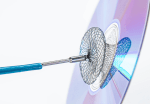Coronary artery disease is common among patients considered for transcatheter aortic valve implantation (TAVI). With the expansion of the indication for TAVI to a population with lower surgical risk, and therefore younger, there has been a gradual increase in the incidence of coronary events. However, there is limited data on treatment strategy and outcomes in<a href="https://solaci.org/en/2024/05/04/acute-myocardial-infarction-after-tavi-retrospective-analysis-of-200000-implants/" title="Read more" >...</a>
Should We Treat Obstructive Coronary Artery Disease in TAVI?
Coronary artery disease, both obstructive and non-obstructive, often coexists with significant aortic stenosis. Therapeutic decision-making in this scenario remains controversial, not only regarding the need for treatment, but also about when it should be addressed, considering its pros and cons. Various analyses have yielded contradictory data, as most lesions are chronic and stable. Currently, the<a href="https://solaci.org/en/2024/02/07/should-we-treat-obstructive-coronary-artery-disease-in-tavi/" title="Read more" >...</a>
Left Atrial Appendage Closure and Concomitant Transcatheter Intervention: Can We?
Several scientific societies support performing left atrial appendage occlusion (LAAO) as a stand-alone procedure, even though it is often associated to other cardiomyopathies requiring transcatheter intervention. Though still controversial, combining LAAO and any other cardiac intervention might reduce hospitalizations, as well as the need for additional punctures, anesthesia, red tape, a longer stay and higher<a href="https://solaci.org/en/2024/02/06/left-atrial-appendage-closure-and-concomitant-transcatheter-intervention-can-we/" title="Read more" >...</a>
Coronary Artery Disease in TAVR: Unsolved Dilemma
Aortic stenosis shares risk factors with coronary artery disease (CAD), and its prevalence varies according to age, reaching approximately 50% or more in some registries. Deciding when to treat and the need for percutaneous intervention presents a challenge. It has been established that epicardial stenosis at proximal level, or the medial segment, requires intervention, especially<a href="https://solaci.org/en/2024/01/30/coronary-artery-disease-in-tavr-unsolved-dilemma/" title="Read more" >...</a>
Carotid Stenosis and TAVR
Aortic Stenosis affects over 5% of the population over 65. Even though TAVR has advanced in the treatment of this disease, many patients present carotid aortic stenosis (CAS), which involves additional surgical risk. This risk has not been thoroughly assessed in the context of TAVR. A meta-analysis was carried out including 5 observational studies with<a href="https://solaci.org/en/2024/01/12/carotid-stenosis-and-tavr/" title="Read more" >...</a>
CAPTIS, a Novel Cerebral Embolic Protection System in TAVR
The incidence of stroke after TAVR ranges between 2 and 5%, depending on the series, which has been associated with higher morbimortality, affecting patient quality of life and their psycho-social environment. Many cerebral embolic protection systems have been developed in response, and even though they have been shown beneficial in many studies, their role in<a href="https://solaci.org/en/2023/11/16/captis-a-novel-cerebral-embolic-protection-system-in-tavr/" title="Read more" >...</a>
Cerebral Embolic Protection Devices: How Useful are they in TAVR?
During TAVR, we often fear the possibility of a stroke, which occurs in approximately 1 – 2% of cases. In general, this phenomenon is caused by thrombi stemming from atherosclerotic or calcified plaque, depending on the etiology. Even though its incidence has declined with technology development and the increasing expertise of operators, it is still<a href="https://solaci.org/en/2023/11/10/cerebral-embolic-protection-devices-how-useful-are-they-in-tavr/" title="Read more" >...</a>
MIL Train More MIL: The Second Week of Training Has Started!
The second group of Women Interventionists sponsored by SOLACI has started the training on structural disease as part of our scholarship program at the Instituto Cardiovascular de Rosario (ICR). The program will take place over the course of this week in different centers across Argentina. During the session, the grant holders were able to attend<a href="https://solaci.org/en/2023/09/27/mil-train-more-mil-the-second-week-of-training-has-started/" title="Read more" >...</a>
Post-TAVI Prosthesis-Patient Mismatch
Prosthesis-patient mismatch (PPM) occurs when the effective orifice area (EOA) after valve placement is significantly smaller compared with the patient’s body surface area (BSA), resulting in an increased transprosthetic residual gradient. The presence of PPM, especially in various surgical series, has been associated with long-term adverse clinical events. In relation to transcatheter aortic valve implantation<a href="https://solaci.org/en/2023/09/06/post-tavi-prosthesis-patient-mismatch/" title="Read more" >...</a>
FRAME-AMI: FFR vs. Angiography of Non-Culprit Vessel in ACS
This study compared fractional flow reserve (FFR) vs. angiography to guide the angioplasty of non-culprit vessels in patients with acute coronary syndrome (ACS) and multivessel disease. Landmark studies such as COMPLETE, COMPARE-ACUTE and DANAMI-3-PRIMULTI have demonstrated the prognostic value of revascularization (after treatment of the artery responsible for the ACS) of non-culprit arteries with respect<a href="https://solaci.org/en/2023/01/25/frame-ami-ffr-vs-angiography-of-non-culprit-vessel-in-acs/" title="Read more" >...</a>









